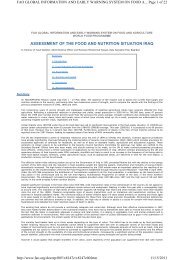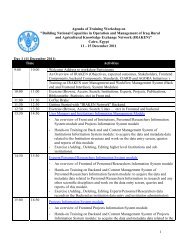Vermiculture in Egypt: - FAO - Regional Office for the Near East and
Vermiculture in Egypt: - FAO - Regional Office for the Near East and
Vermiculture in Egypt: - FAO - Regional Office for the Near East and
You also want an ePaper? Increase the reach of your titles
YUMPU automatically turns print PDFs into web optimized ePapers that Google loves.
enclosure could not be ascribed with certa<strong>in</strong>ty to ei<strong>the</strong>r of <strong>the</strong> latter two species <strong>and</strong><br />
are <strong>the</strong>re<strong>for</strong>e recorded separately.<br />
1.6. <strong>Vermiculture</strong> <strong>and</strong> vermicompost<strong>in</strong>g<br />
<strong>Vermiculture</strong> is <strong>the</strong> process of breed<strong>in</strong>g worms. Growers usually pay <strong>for</strong> <strong>the</strong>ir<br />
feedstock, <strong>and</strong> <strong>the</strong> worm cast<strong>in</strong>gs are often considered a waste product. <strong>Vermiculture</strong><br />
is <strong>the</strong> culture of earthworms. The goal is to cont<strong>in</strong>ually <strong>in</strong>crease <strong>the</strong> number of worms<br />
<strong>in</strong> order to obta<strong>in</strong> a susta<strong>in</strong>able harvest. The worms are ei<strong>the</strong>r used to exp<strong>and</strong> a<br />
vermicompost<strong>in</strong>g operation or sold to customers who use <strong>the</strong>m <strong>for</strong> <strong>the</strong> same or o<strong>the</strong>r<br />
purposes.<br />
Vermicompost<strong>in</strong>g, is a simple biotechnological process of compost<strong>in</strong>g, "Vermi" is a<br />
Lat<strong>in</strong> word mean<strong>in</strong>g "worm" <strong>and</strong> thus, vermicompost<strong>in</strong>g is compost<strong>in</strong>g with <strong>the</strong> aid of<br />
worms, <strong>in</strong> which certa<strong>in</strong> species of earthworms are used to enhance <strong>the</strong> process of<br />
waste conversion <strong>and</strong> produce a better end product. Vermicompost<strong>in</strong>g differs from<br />
compost<strong>in</strong>g <strong>in</strong> several ways. It is a mesophilic process, utiliz<strong>in</strong>g microorganisms <strong>and</strong><br />
earthworms that are active at 10–32°C (not ambient temperature but temperature<br />
with<strong>in</strong> <strong>the</strong> pile of moist organic material). The process is faster than compost<strong>in</strong>g;<br />
because <strong>the</strong> material passes through <strong>the</strong> earthworm gut, a significant but not yet fully<br />
understood trans<strong>for</strong>mation takes place, whereby <strong>the</strong> result<strong>in</strong>g earthworm cast<strong>in</strong>gs<br />
(worm manure) are rich <strong>in</strong> microbial activity <strong>and</strong> plant growth regulators, <strong>and</strong> <strong>for</strong>tified<br />
with pest repellence attributes as well (Munroe, 2007). In short, earthworms, through<br />
a type of biological alchemy, are capable of trans<strong>for</strong>m<strong>in</strong>g garbage <strong>in</strong>to valuable<br />
material (Nagavallemma et al., 2004). The ultimate goal of vermicompost<strong>in</strong>g is to<br />
produce vermicompost as quickly <strong>and</strong> efficiently as possible. If <strong>the</strong> goal is to produce<br />
vermicompost, maximum worm population density needs to be ma<strong>in</strong>ta<strong>in</strong>ed all of <strong>the</strong><br />
time. If <strong>the</strong> goal is to produce worms, population density needs to be kept low enough<br />
that reproductive rates are optimized.<br />
It is known that many extracellular enzymes can become bound to humic matter<br />
dur<strong>in</strong>g a compost<strong>in</strong>g or a vermicompost<strong>in</strong>g process, regardless of <strong>the</strong> type of organic<br />
matter used, but knowledge of <strong>the</strong> chemical <strong>and</strong> biochemical properties of such<br />
extracellular enzymes is very scanty (Benítez et al., 2000).<br />
Vermitechnology has been promoted as an eco-biotechnological tool to manage<br />
organic wastes generated from different sources (Suthar, 2010).<br />
Vermicast, similarly known as worm cast<strong>in</strong>gs, worm humus or worm manure, is<br />
<strong>the</strong> end-product of <strong>the</strong> breakdown of organic matter by a species of earthworm.<br />
Vermicast is very important to <strong>the</strong> fertility of <strong>the</strong> soil. The cast<strong>in</strong>gs conta<strong>in</strong> high<br />
amounts of nitrogen, potassium, phosphorus, calcium, <strong>and</strong> magnesium. Cast<strong>in</strong>gs<br />
conta<strong>in</strong>: 5 times <strong>the</strong> available nitrogen, 7 times <strong>the</strong> available potash, <strong>and</strong> 1½ times<br />
more calcium than found <strong>in</strong> good topsoil. It has excellent aeration, porosity, structure,<br />
dra<strong>in</strong>age, <strong>and</strong> moisture-hold<strong>in</strong>g capacity. Vermicast can hold close to n<strong>in</strong>e times <strong>the</strong>ir<br />
weight <strong>in</strong> water. It is a very good fertilizer, growth promoter <strong>and</strong> helps <strong>in</strong>duc<strong>in</strong>g<br />
flower<strong>in</strong>g <strong>and</strong> fruit-bear<strong>in</strong>g <strong>in</strong> higher plants. This can even help plants to get rid of<br />
pests <strong>and</strong> diseases (Venkatesh <strong>and</strong> Eevera, 2008 ).<br />
8





